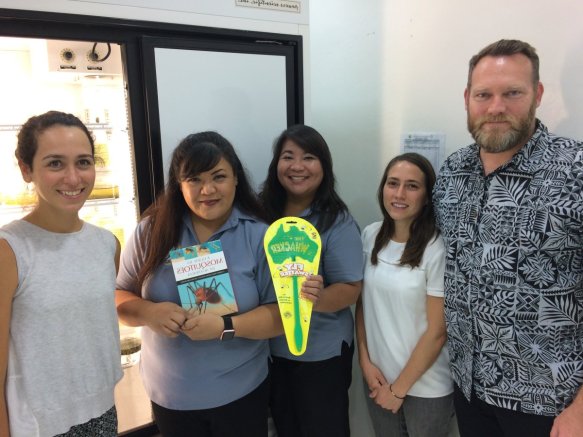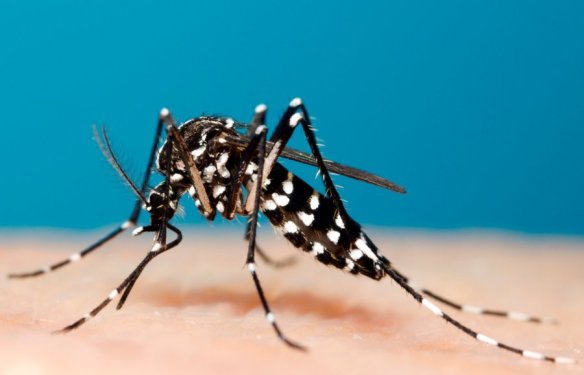
There are few places on earth where you can search in water-filled canoes for one of the most dangerous mosquitoes on the planet less than a stone’s throw from tourists posing for selfies alongside their inflatable novelty swans in the nearby lagoon.
Guam is the place to go if you need to tick that off your “to do” list!
I was fortunate to be invited to speak at the Pacific Island Health Officers Association (PIHOA) Regional Zika Summit and Vector Control Workshop in Guam 25-29 June 2017. The theme of the summit was “Break Down the Silos for Preparedness and Management of Emergencies and Disasters in United States Affiliated Islands” and had objectives to critical analyze the regional responses to recent mosquito-borne disease outbreaks while developing policies to strengthening public health emergency response and preparedness systems and capabilities within the region.
The tranquil lagoons of the Pacific Islands may seem a very long way from the hustle and bustle of the busy South American cities that held the 2016 Olympics but just as Zika virus was grabbing the attention of sports reporters everywhere, health authorities active in the Pacific were growing concerned too.

The Pacific has been far from free of mosquito-borne disease outbreaks. Previous outbreaks of dengue, chikungunya and even Ross River virus had struck numerous times. While sometimes widespread, at other times outbreaks were more sporadic or isolated. As is the case for many non-endemic countries, outbreaks are prompted by movement of infected travelers and the prevalence of local mosquitoes.
Across the region there are four mosquitoes of primary concern, Aedes aegypti, Aedes albopictus, Aedes polynesiensis and Aedes hensilli. The greatest concerns are associated with Aedes aegypti and in those countries where the mosquito is present, the risks of mosquito-borne disease outbreak are greatest. For this reason alone, it is imperative that good entomological surveillance data is collected to confirm the distribution of these mosquitoes but also to develop strategies to eradicate, where possible, Aedes aegypti should it be introduced to new jurisdictions.
With a growing interest in developing mosquito surveillance and control programs for exotic mosquitoes here in Australia, it was a perfect opportunity for me to get a closer look at how the threats of these mosquitoes and associated outbreaks of disease are managed.
On the third day of the meeting, vector control took centre stage. A brilliant day of talks from each of the jurisdictions on the disease outbreaks they’ve faced and how they’re preparing for future threats. There were presentations from the United States Affiliated Pacific Islands (USAPI) including Guam, the Federated States of Micronesia (Yap, Kosrea, Chuuk, Pohnpei), the Commonwealth of the Northern Marianas (CNMI), the Republic of Palau, the Republic of Marshall Islands (RMI), and American Samoa.
Hearing from these teams doing their best to protect their local communities from the threat of mosquito-borne disease, with only limited resources, was quite eye opening. There was passion and dedication but each territory faced unique challenges to ensure the burden of disease is minimised.

Just outside the workshop venue were a series of water-filled canoes. Most contained larvae!
There is little doubt that climate variability will have a strong role to play in the impacts of mosquito-borne disease across the region in the future but there are so many other issues that could be contributing to increased risk too. One of the biggest problems is rubbish.
Time and time again, the issue of accumulated waste, especially car bodies and discarded tyres, was raised as a major problem. As many of the key pest mosquitoes love these objects that trap water, treatment of these increasing stockpiles becomes more of a concern. Community wide cleanups can help reduce the sources of many mosquitoes but the rubbish more often than not remains on the island and requires continued management to ensure is not becoming a home to millions of mosquitoes.
It is a reminder that successful mosquito control relies on much more than just insecticides. An integrated approach is critical.
There was a “hands on” session of surveillance and control. Coordinated by PIHOA’s Eileen Jefferies and Elodie Vajda, the workshop was a great success. It provided an opportunity for many to see how to prepare ovitraps and BGS traps (one of the most widely used mosquito traps) and discuss the various considerations for choosing and using the right insecticides to reduce mosquito-borne disease risk. Workshop attendees were also the luck recipients of a selection of cleaver public awareness material produced in Guam, from personal fans and anatomically incorrect plush mosquitoes to Frisbees and mosquito-themes Pokemon cards!

Guam “mozzie” team: Elodie Vajda, Claire Baradi, Michelle Lastimoza, Eileen Jefferies and me
Following the summit, there was a chance to visit the new Guam “Mosquito Laboratory”, newly established as part of the Guam Environmental Public Health Laboratory (GEPHL). I’ll go out of my way to visit any mosquito laboratory but I was particularly keen to see this one as one of my previous students was playing a key role in establishing the mosquito rearing and identification laboratories. Elodie has been doing an amazing job and it was brilliant to geek out with her over some hard core mosquito taxomony as we tried to ID a couple of tricky specimens. [Make sure you check out our recent paper on the potential impact of climate change on malaria outbreaks in Ethiopia]
It actually turned out that one of their “tricky specimens” was a new species record for Guam – an exotic mosquito Wyeomyia mitchellii! The paper reporting this finding has just been published “New Record of Wyeomyia mitchellii (Diptera: Culicidae) on Guam, United States“.

Mosquito-borne disease in the Pacific isn’t going anywhere and it’s important that once the focus fades from Zika virus, dengue and chikungunya viruses will again take centre stage and their potential impacts are significant. With the added risks that come with gaps in the understanding of local pest and vector species, the prevalence of insecticide resistance among local mosquitoes, climate variability and a struggle to secure adequate funding, challenges lay ahead in ensuring the burden of mosquito-borne disease doesn’t increase.
A modified version of this article appears in the latest issue (Winter 2017; 12(1)) of Mosquito Bites Magazine, (a publication of the Mosquito Control Association of Australia)




